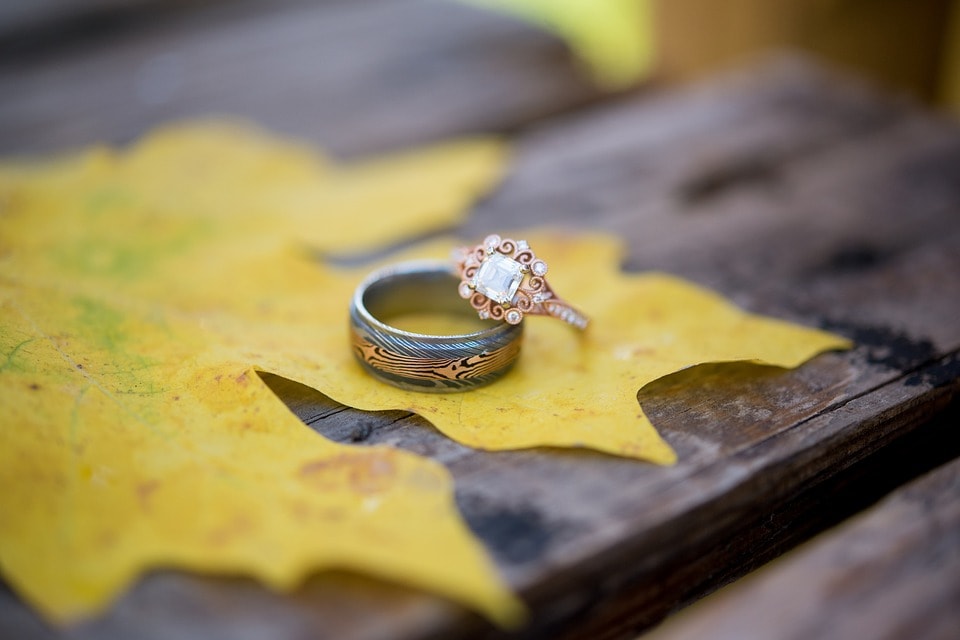
Table of Contents
The Asscher cut is one of the most elegant and sophisticated of all the diamond cuts and is the fourth most popular shape for diamond engagement rings in the world today.
This classic cut has been a favorite for decades and has been increasing in popularity of late. It is ideal for engagement rings as it has the contemporary sophisticated look of the princess cut with the intriguing, vintage touch of the emerald. When cut expertly, the Asscher is stunning and eye-catching.
Finding a high quality Asscher is rare and will require some active searching, especially because it is among the rarer diamond cuts. Here we outline what you need to know before you buy an Asscher cut diamond.
What is the Asscher Cut?
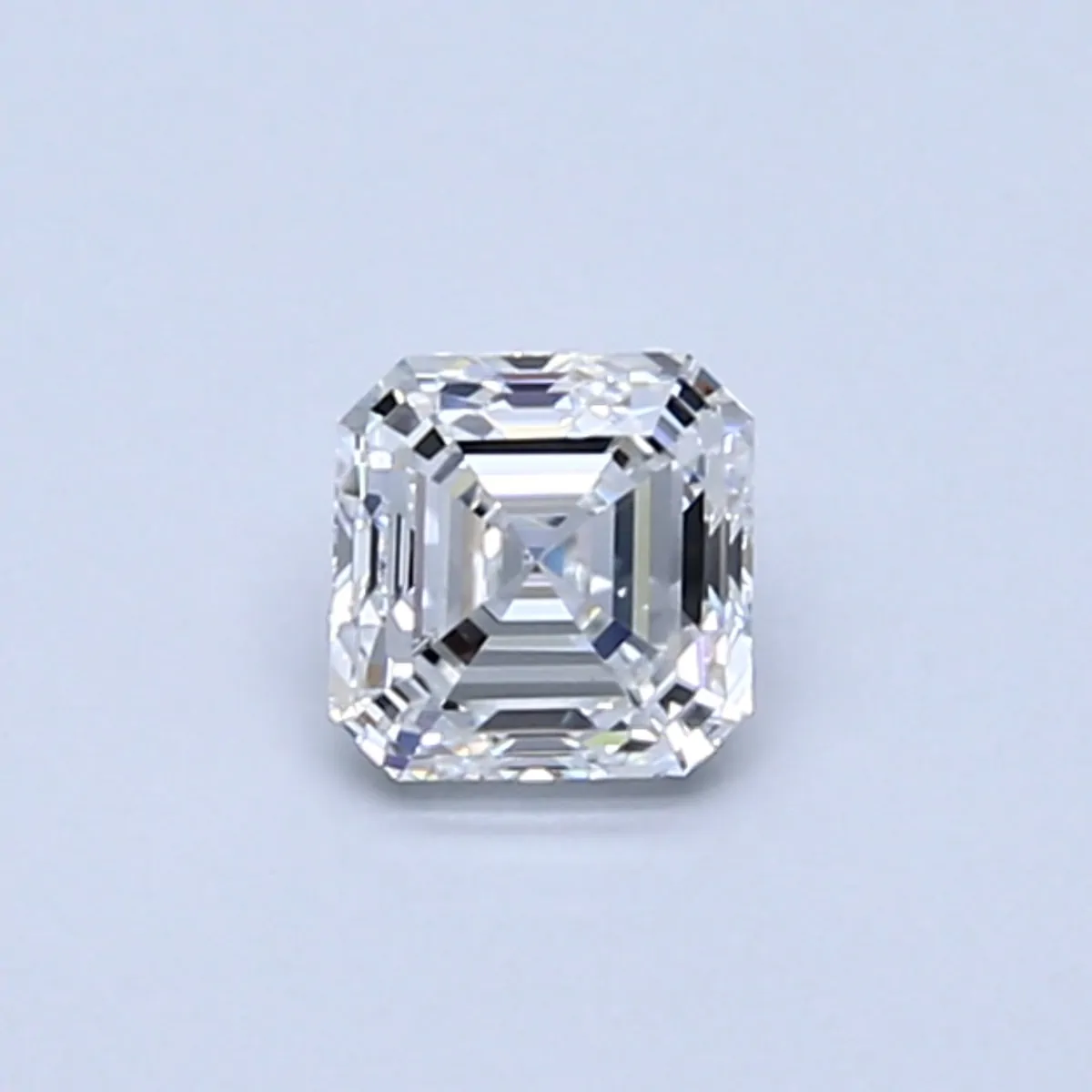
The Asscher cut is a relatively recent addition to diamond cuts. It was first developed in 1902 by Joseph Asscher of the famous Asscher family, known for their innovation and cutting experience in the world of large and rare gems. As it’s named after a family, the Asscher is the only diamond cut that has a name starting with a capital letter. It’s also the only cut that was patented.
There are two versions of the Asscher – the standard Asscher cut with 58 facets and the Royal Asscher cut which is a modified Asscher with a total of 75 facets. During the Art Deco period, the Asscher enjoyed roaring success. It fit in perfectly with the style of the era – geometric in design, with clean, minimalist lines.
Like the emerald shape, the Asscher is also a step cut but it shows more brilliance and sparkle, thanks to its unique arrangement of facets. The Asscher later began to decline in popularity, until Joseph Asscher’s great-grandnephew created a new version of the cut – the Royal Asscher which brought the cut back into the spotlight.
What Settings Work Best for the Asscher Cut?
The Asscher cut does not have any specific vulnerable points, unlike the pear or marquise cuts, meaning that it does not require a protective setting. It is also a very versatile shape and goes well with most settings and styles.
- For prong settings, 4 prongs are the most common for Asscher cut diamonds. This will hold the diamond securely from all four corners.
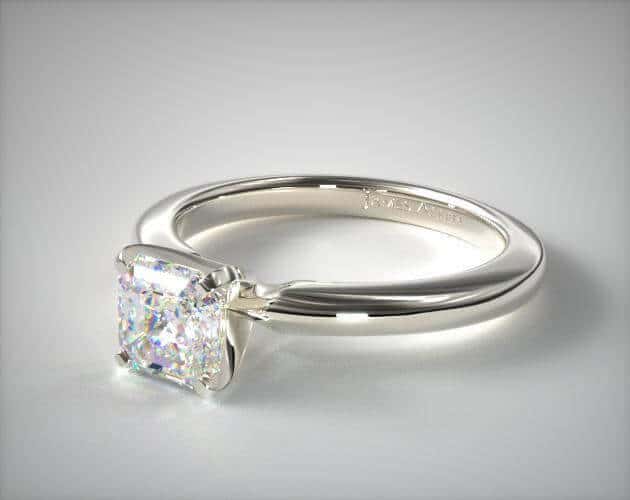
- This cleverly designed setting appears to have 4 prongs but actually consists of 8, which provides added security for the diamond and is also highly aesthetic.
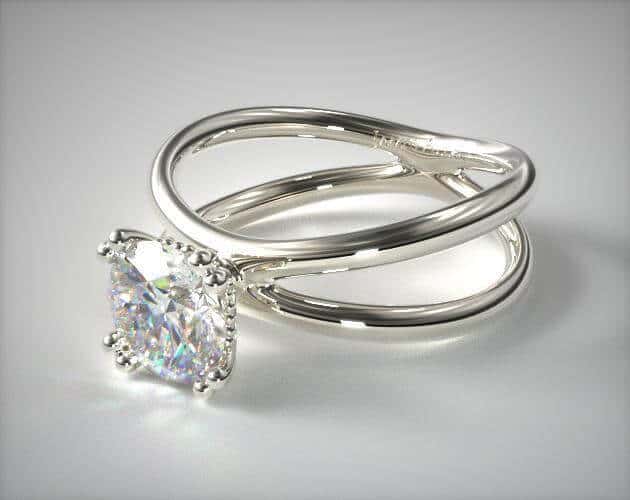
- A halo setting is especially stunning for Asscher cut diamonds as it adds that extra sparkle and brilliance that the Asscher lacks, creating an excellent combination. It also provides extra protection for the stone.
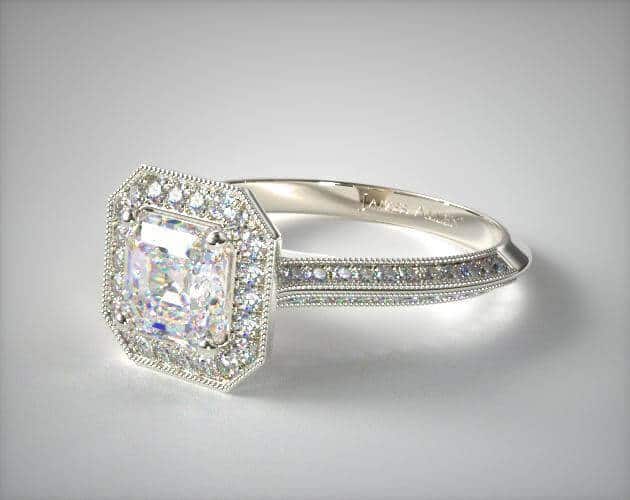
- The three-stone setting also works beautifully for Asscher diamonds, as it adds sparkle and depth to the stone. Because of the Asscher’s versatile cut, you can choose almost any shape for the side stones. The example below shows marquise shaped accent stones.
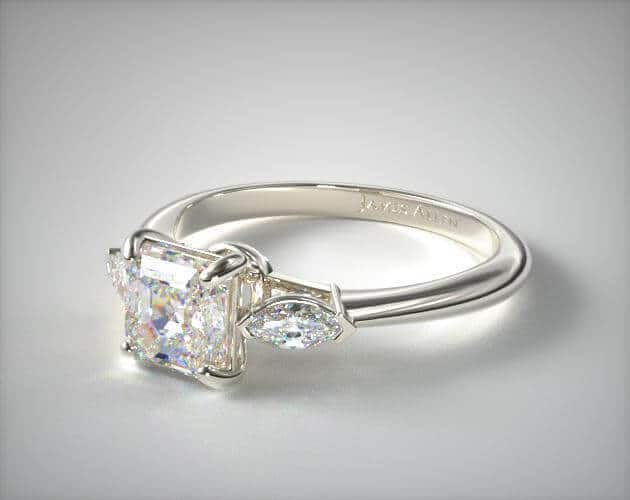
- The Asscher cut lends itself well to vintage settings, and is especially beautiful set in Art Deco designs.
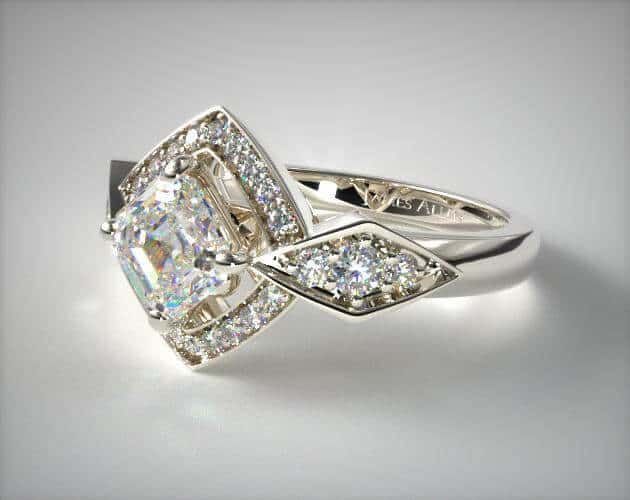
What Settings Should You Avoid?
As we’ve seen, the Asscher goes well with most ring settings. However, settings overpower the central diamond by hiding its size and shine. Bezel settings, for example, are not ideal for Asscher cuts as they tend to hide a lot of the diamond and do not add to its sparkle.
Having said that, bezel settings also provide the greatest protection for a diamond, preventing chips and breakage around the edges.
How Do You Evaluate the Cut Grade of an Asscher Diamond?
The Asscher cut is valued for its clarity and smooth luster, not for its brilliance. So if you’re after a brilliant, sparkling diamond, this is not it. But a well-cut Asscher showcases the depth and beauty of the diamond in a way quite different from other cuts.
Unfortunately, choosing the cut of an Asscher is difficult, as there’s no industry standard that evaluates these cuts. The GIA does not grade the cut quality of fancy cut diamonds, and therefore, having an understanding of the quality factors will assist you in making an informed decision.
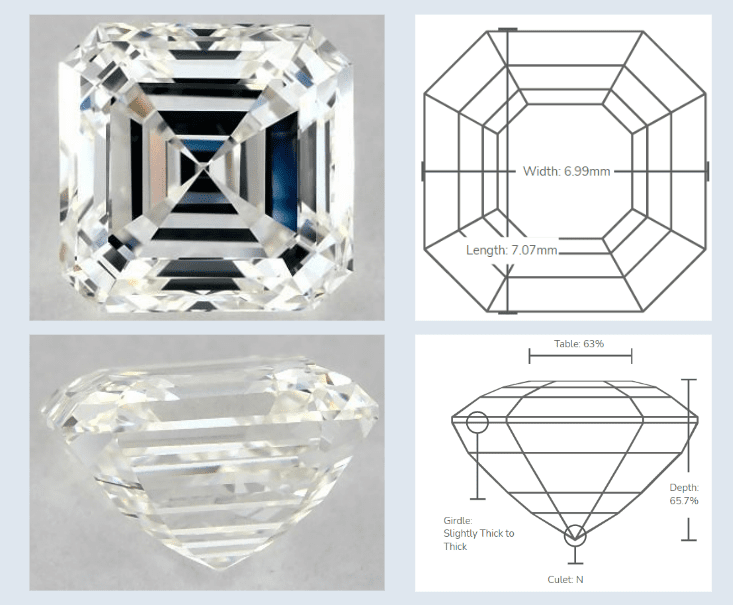
The advanced search filters on most diamond sites allow you to set these parameters as required. Here are the main factors to look for:
- Depth – The Asscher is a deep cut, which results in a large portion of the diamond being beneath the surface. It’s best to choose a depth percentage between 60% to 67% as a shallower depth means a larger looking diamond.
- Table – For the table percentage, choose between 60% to 69% for the best look.
- Polish and Symmetry – Choose Good, Very Good or Excellent for polish and symmetry.
- Length to Width Ratio – Choose a Length to width ratio of 1:00 to 1:05 for the perfect square.
Choose the Length to Width Ratio
The Asscher is a square cut and traditionally has a length to width ratio of 1:00. In other words, each of the four sides has the same length.
However, the cut can also be modified for a more rectangular appearance by changing up the length to width ratio. A length to width ratio up to 1:60 is recommended, as anything more than this will simply look too narrow.
The shape of the stone you choose is a matter of preference as there is no right or wrong shape here. However, most Asscher cuts are square, so finding a rectangular one may be difficult.
Avoid Bad Cuts – Windows and Extinction
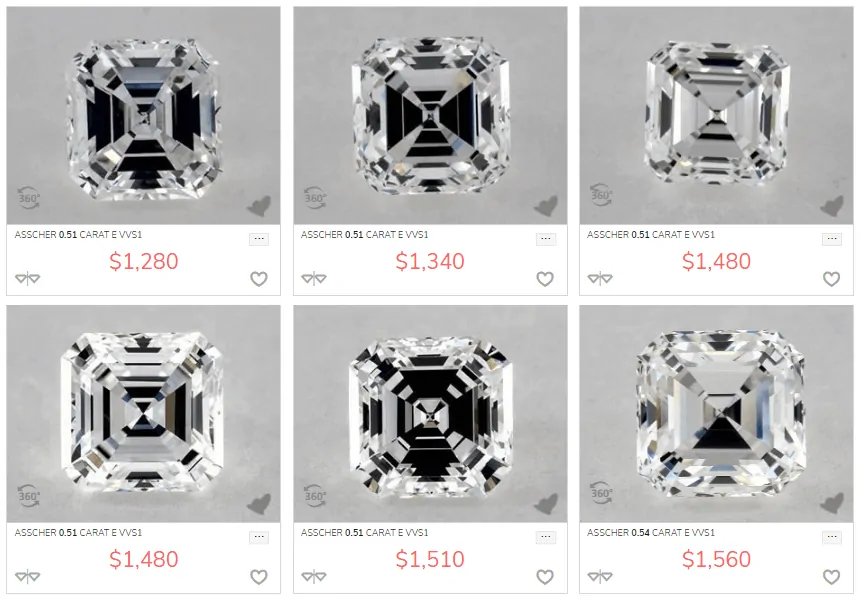
Windows and extinction occur in Asscher cuts when the stone has been cut badly and the symmetry and proportion is not spot on.
Windows refers to large white spaces in the diamond, which do not reflect light back to you. Instead, they allow you to see right through the stone. Extinction is the opposite effect, where there are darkened areas in the stone often caused by misaligned facets. Often, this occurs only when seen at certain angles. There will be little light reflection in these areas, decreasing the brilliance and beauty of the stone.
If these factors are the first thing you see when you look at your Asscher cut diamond, it’s best to choose a different stone. This is why it is important to see images and video of the actual stone rather than a stock image, as the grading report will not provide this information.
Have a look at the screenshot above of a random selection of Asscher cut diamonds from James Allen. The diamonds have similar specifications and prices but when viewed face-up, each appears quite different. The third and fourth have the best look, while some have serious extinction. On paper, all these diamonds would appear nearly identical as they have similar features.
What’s the Best Color Grade for Asscher Cut Diamonds?
The Asscher shows color easily, because of its clean facets. What this means is that if you compromise on the color grade, your stone may show the tints quite clearly.
Having said that, the setting you choose impacts the stone in a major way. Notice the two Asscher cut diamond rings below. The white gold setting brings out the colorlessness of the stone whereas the yellow gold setting exhibits a yellowish tint in the stone. By choosing the right color grade and setting, you can maximize your budget while still getting a stunning stone.
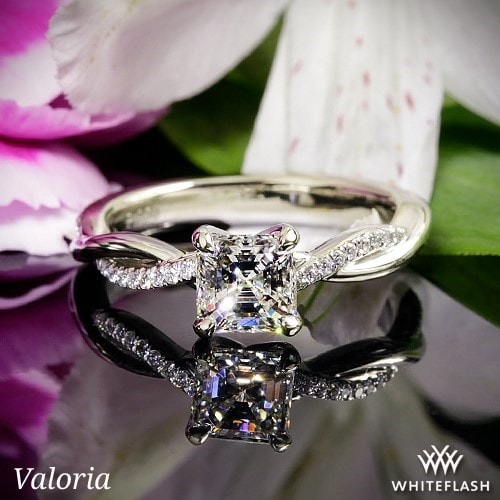
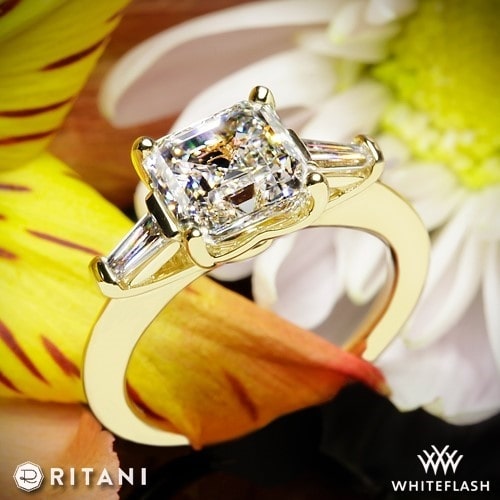
For the perfect whiteness and luster, choose a diamond from the D – F range. However, because the difference between these three grades is so slight, paying a premium for a D-grade diamond is hard to justify, so we recommend dropping down to an F diamond.
For example, compare these two diamonds which are similar in features except in color grades. The difference in price is over $1000.
Diamond 1 – Asscher cut diamond .71 carat weight and D grade
Diamond 2 – Asscher cut diamond .71 carat weight F grade
You can drop further down to an I-grade diamond like this one and still have a stone that looks great but also saves you a considerable amount of money. This will give you the best value for your Asscher cut diamond.
If you choose a yellow gold setting, you can drop the color grade down to K – J as the contrast with the metal reduces the appearance of the tints in the stone.
What’s the Best Clarity Grade for Asscher Cut Diamonds?
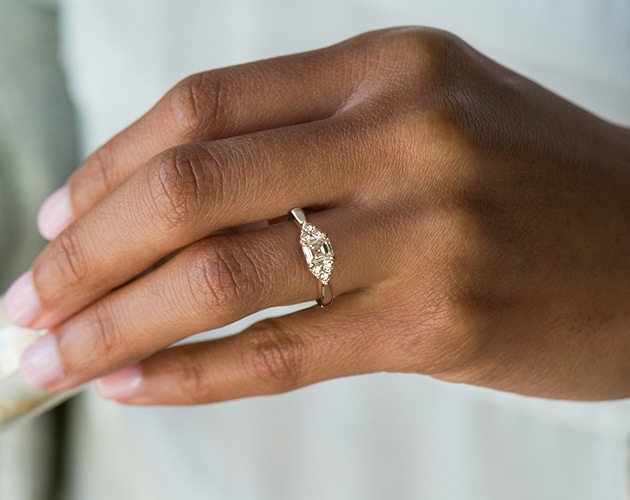
Steps cuts, like Asscher and emerald, are not great at hiding inclusions. This means that you have to choose the clarity grade of your diamond carefully. The purpose of the Asscher is to showcase the diamond’s clarity. This purpose will be defeated if there are visible unsightly flaws.
Brilliant diamond shapes such as round and princess, play with light in a unique way due to their faceting arrangements, creating intense sparkle and fire. This makes it easier for impurities and flaws to remain hidden within the diamond. The Asscher cut does not have this brilliance and fire. Instead, its long open facets show off the diamonds clarity and smooth look as it is.
The best clarity grades would be Very Slightly Included (VS2) and better for Asscher cuts, although you may be able to drop down to a S1 depending on where the inclusions are located. This diamond is an S1 Asscher but appears eye-clean, making it good value for money.
The critical point is that flaws are not visible to the naked eye. Inclusions will be visible in larger stones, so it’s best not to compromise on quality in this aspect. Ensure that you images of the actual stone, as that provided by James Allen’s Diamond View Technology, to make sure that the stone is eye-clean.
Where to Buy Asscher Diamonds Online
Ensure that the retailer you choose to purchase from is licensed and reputable, with a history of good service. Check that they provide you with a certificate of authenticity for your diamond. The certifying lab should be recognized such as GIA, AGS, IGI or EGL.
If you are purchasing an antique Asscher cut ring, always request an appraisal or certificate of authenticity for the ring. Because the ring will already be mounted, it cannot be evaluated like a loose diamond. If you have any doubts, you can always ask an expert to check it for you.
Also, ensure that you see images and/or videos of the actual diamond and not simply a stock photo to check for symmetry, eye-cleanliness, and light performance. It’s best to choose a respected retailer such as James Allen who offers high-quality photos and special Diamond Display Technology that will allow you to inspect your diamond closely. Also, check that the after-sales policies are solid including returns and warranty.
We recommend the following retailers:
Why: Superior diamond imaging, competitive prices, high quality, wide range
An online giant in the diamond space, James Allen a stunning collection of high-quality round diamonds. The images and videos are unparalleled in quality and makes shopping online similar, if not better, to shopping in store.
Why: Competitive prices, wide range, great quality
Known for dominating the online diamond industry since the late 1990s, Blue Nile offers one of the largest online diamond inventories. Search round diamonds here at competitive prices, solid after-sales policies, and good customer service.
Why: Superior cut quality, exclusive range, stunning designs
Whiteflash has earned an international reputation for the elite quality of their precision cut diamonds and for their impeccable collection of designer engagement rings. Check out their stunning range of diamond jewelry and loose diamonds.
Why: Impeccable quality, superior cut, small but exclusive inventory
Brian Gavin is a renowned expert in diamond cut – and it shows in their superior diamond quality. For the very best in diamonds, search their inventory of designer diamond jewelry and loose diamonds.
Why: Try before you buy, build your own ring, great quality
If you want to try out how a round diamond ring looks on your finger before you commit to buying one, check out With Clarity’s Home Preview Service which is completely free. Find out more here.
Wrapping Up
Stylish and modern, the Asscher cut is the epitome of class and elegance when it comes to diamonds. As a step cut diamond, it requires greater clarity and color quality, but as it’s a more affordable diamond cut, you don’t have to break the bank to buy a high-quality Asscher gemstone.
If you’re looking to purchase an Asscher stone, we recommend starting your browsing here.









